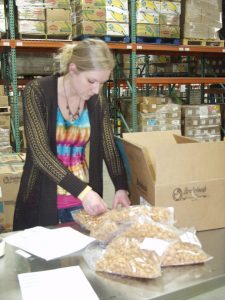The Volunteer Center’s newest hunger-relief agency started back in 1982, when members of the Rotary Club of Milwaukee opened a food bank with a bushel of apples donated by a local farmer to help those facing hunger. Two years later, Feeding America Eastern Wisconsin opened in a small warehouse in Milwaukee under its original name, America’s Second Harvest of Wisconsin.

Today, Feeding America Eastern Wisconsin is the leading hunger-relief agency in the state, operating food banks in Milwaukee and the Fox Valley.
It distributes more than 25 million pounds of food each year to people in Wisconsin. That translates to feeding nearly 400,000 people yearly.
Feeding American Eastern Wisconsin opened its Fox Valley facility in November 2015, a state-of-the-art foodbank on Appleton’s north side. It works with more than 200 member food pantries, shelters and meal programs.
Carol Bloemer, director of the Retired & Senior Volunteer Program (RSVP), said the Volunteer Center is pleased that Feeding America provides another opportunity for volunteers age 55 and better to combat hunger in the community.
“A total of 32 RSVP volunteers serve at various nonprofit agencies by registering clients at food banks, sorting donations, and preparing and serving meals,” she said. “In 2017, these volunteers served a total of 2,447 hours at local agencies.”
Liz Wollenberg, donor relations manager at Feeding America, said volunteers work with large quantities of food.
“Our two food banks serve as the distribution center for 600+ food pantries, meal programs and shelters who partner with us to get food to those facing hunger,” she said. “Volunteers who work with us have the opportunity to see first-hand how millions of pounds of food come into our food banks from our donors, is inventoried, checked for safety, and then sorted and packaged before being distributed to our member agencies.”
Particularly during National Volunteer Appreciation Week, which is April 15-24, the agency will work with many local companies and corporations who offer paid volunteer time for their employees. Feeding America also works with large groups of students. Volunteer groups can range from 50 to 100 people on a project.
Volunteers pack, label, sort or clean products. Folks might label canned goods to be shipped to food pantries, sort meat products to provide meal programs with protein, box fresh produce to send to shelters or pack bulk products into family-sized portions.
Volunteers work three-hour shifts during the week, Monday through Friday from 9 a.m.-noon or 1-4 p.m. and twice a month on Saturday from 9 a.m.-noon.
Wollenberg said their greatest challenge is dealing with the fluctuation in volunteerism throughout the year. She explained that during the holidays, everyone is in the holiday spirit, so the agency receives a tremendous amount of donations and volunteers. But when the winter months set in, it’s a different story.
“We lose a lot of volunteers during the winter months,” she said. “Some of our retired volunteers spend the winters in warmer climates and, for others, volunteering is just not top of mind after the holidays. But the need is always there. People are hungry year-round.”
Wollenberg explained that at the end of each shift, the staff person who is working with the group calculates how many pounds of food they packed and the impact it will have on people in northeast Wisconsin in two or three days.
“So we can tell them, you packed 3,000 pounds of food today, which is equivalent to 2,500 meals,” she said. “So in three hours, you just helped to feed 2,500 people or a family for a year. It’s incredible when you make that connection.”
Wollenberg said that although the agency relies on the 50- to 100-person groups to move a lot of food, they depend on their regular volunteers – those who volunteer two to three times a week – to come in and be the backbone of the organization.
“They are used to seeing each other every week,” she said. They know about each other’s family and friends. They created their own little community of volunteering here.”

